MARIANI’S
Virtual Gourmet
DECEMBER
6, 2015
NEWSLETTER

IN THIS ISSUE
TIME TO THINK ABOUT MIAMI?
By John Mariani
NEW YORK CORNER
IL VALENTINO
By John Mariani
and
MULINO A VINO
By Mort Hochstein
NOTES FROM THE WINE CELLAR
What's Old Is Now New in Bordeaux
By Brian Freedman
THINKING ABOUT MIAMI?
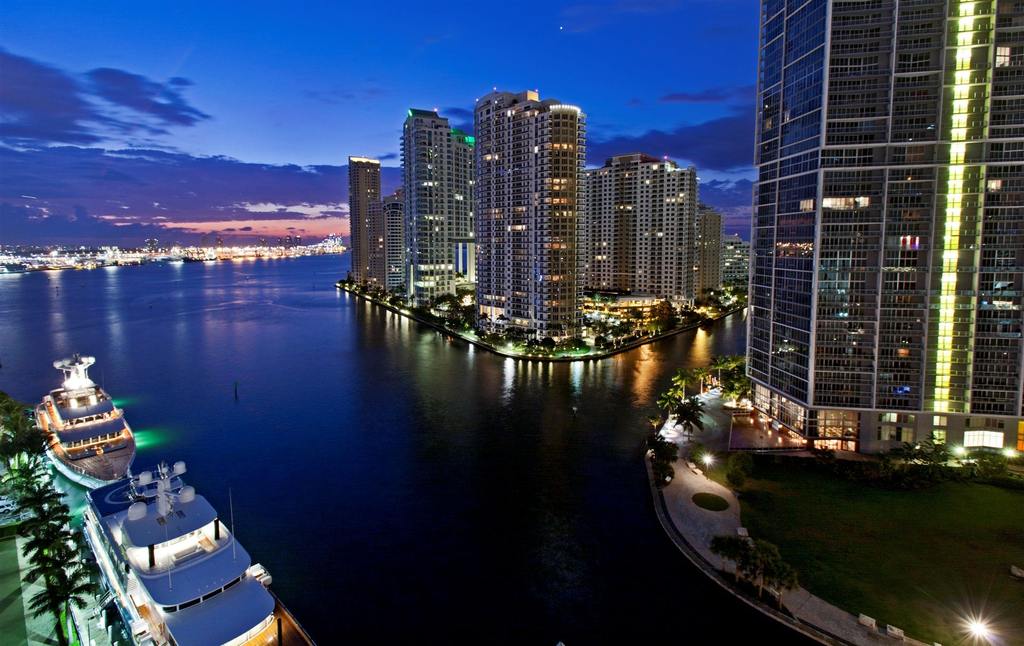
Anyone who does not
live in Florida right now may find the thought
of visiting enticing. Not just because of the
warmer weather but because, unlike most of the
Caribbean islands, the state of Florida and, in
particular, the city of Miami have far more
attractions than mere sand, sun, and duty-free
trinket shops.
Also, Miami is riding one
of its periodic booms, with the inevitable bust
nowhere in sight.
And a lot of the activity and culinary
flavor is coming out of the mainland city, not
Miami Beach, now more than ever a tourist lure
and a location for regional magazine photo
shoots.
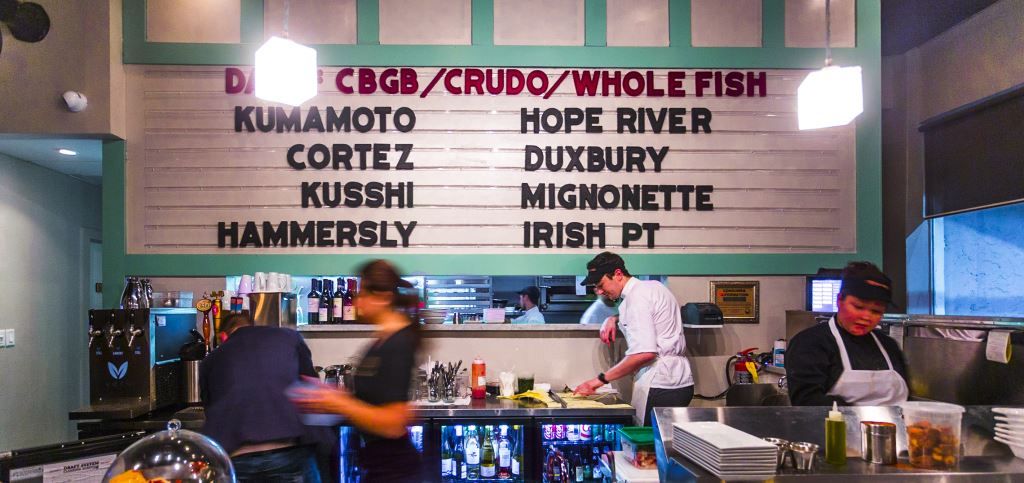 One of the
best new restaurants in Miami proper is MIGNONETTE
(210 NE 18th Street;
305-374-4635), near
Biscayne Park, devoted
largely to high-quality seasonal seafood and a
good time for everyone. Executive chef-owner
Daniel Serfer also runs Blue Collar, serving
American comfort food, and Mignonette does the
same with seafood, drawing on his experience
cooking at The
15th Street Fisheries & Dockside Café in Fort
Lauderdale. Mignonette is co-owned by local food
writer Ryan Roman; chef de cuisine is Bobby Frank.
One of the
best new restaurants in Miami proper is MIGNONETTE
(210 NE 18th Street;
305-374-4635), near
Biscayne Park, devoted
largely to high-quality seasonal seafood and a
good time for everyone. Executive chef-owner
Daniel Serfer also runs Blue Collar, serving
American comfort food, and Mignonette does the
same with seafood, drawing on his experience
cooking at The
15th Street Fisheries & Dockside Café in Fort
Lauderdale. Mignonette is co-owned by local food
writer Ryan Roman; chef de cuisine is Bobby Frank.
The restaurant is carved out of
a 1930s gas station space, and feel free to drop
in wearing whatever you’re wearing, sit at the
counter and just slurp down the shellfish, or take
a table, order some craft beers or a bottle of
wine (from a too short list) and feast on apps
like charred octopus with tazzo ham, pigeon peas
and crisp hoppin’ john fritters ($15). The
crab cake ($17) is much in need of lump meat. Your
table of four may want to 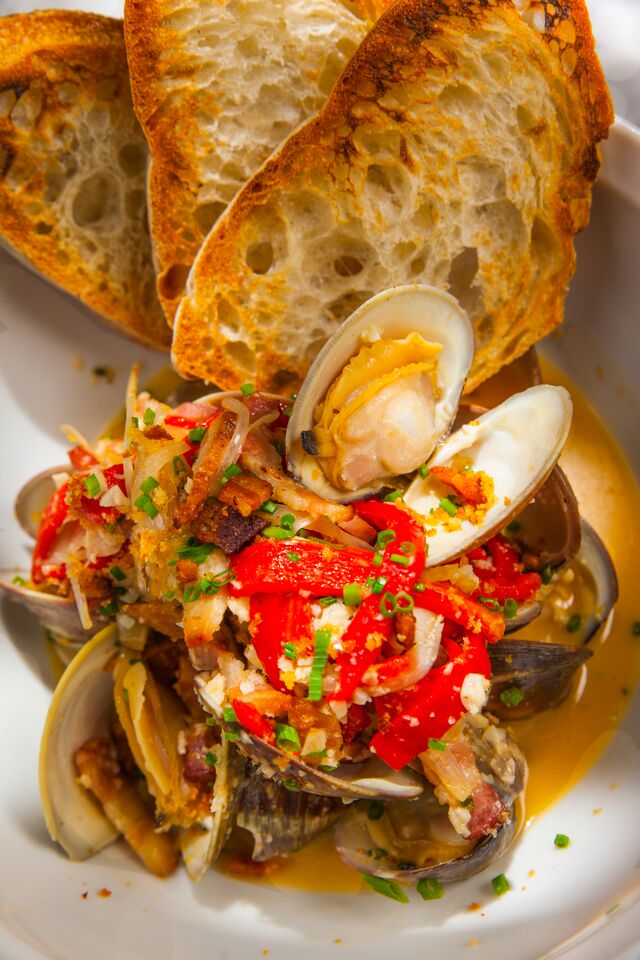 go for the lavish
“fancy” seafood tower of the day’s best shellfish
($95).
go for the lavish
“fancy” seafood tower of the day’s best shellfish
($95).
You can be very be happy with
the plain, simply grilled Caribbean and Gulf red
fish ($23), crisp-skinned snapper ($24) or grouper
($21), so don’t bother with frozen South African
lobster tails ($35). A far better choice is the
lobster roll with a generous amount of meat piled
high on a Portuguese roll with drawn butter and
served with fried potato chips ($25), or the
seared redfish with green beans, piquillo peppers
and brandy pan sauce ($25).
Why, then, would anyone go to
Mignonette for bone-in prime rib ($37)? Because
it is really,
really delicious and has become justifiably
popular with the regulars.
Mignonette
is a very casual place but it’s got serious
intent, and its location near Artopia brings in an
eclectic, and attractive, crowd. You’ll
enjoy the hell out of the place.
On Miami
Beach, THE
SOCIAL CLUB at SURFCOMBER HOTEL (1717 Collins Avenue;
305-53-7715)
is one big, open room with an engaging and very
colorful bar/lounge, where you can also get some
of the best breakfasts on Miami Beach. The
challah French toast is fantastic, and the
buttermilk pancake is worth neglecting your beach
diet for.
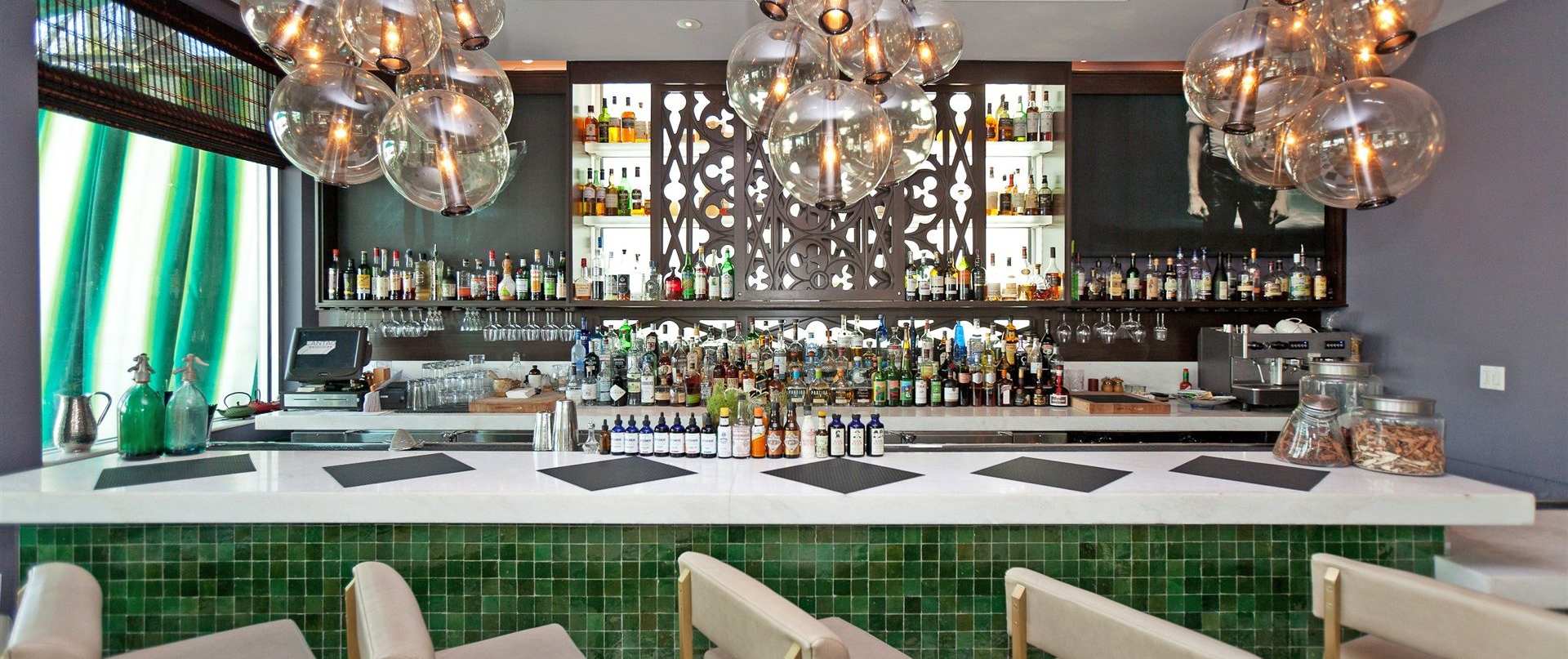 This is a
Kimpton hotel, so they’re not holding back on a
brightly colored contemporary design aimed at a
youth market. They call it “Trendy, Funky, Modern,
and Cool,” packing delightful retro elements into
the skeleton of an old art deco hotel. This
means, however, that the average room is only
about 200 square feet, and you’ll be hard put to
squeeze two people into the bathroom at once, even
with a very close shave. The windows have Venetian
blinds, some with a view of the pool and beach,
but I suspect few people spend much time in the
rooms.
This is a
Kimpton hotel, so they’re not holding back on a
brightly colored contemporary design aimed at a
youth market. They call it “Trendy, Funky, Modern,
and Cool,” packing delightful retro elements into
the skeleton of an old art deco hotel. This
means, however, that the average room is only
about 200 square feet, and you’ll be hard put to
squeeze two people into the bathroom at once, even
with a very close shave. The windows have Venetian
blinds, some with a view of the pool and beach,
but I suspect few people spend much time in the
rooms.
Downstairs in The Social Club,
Chef Wilson Blair is showcasing modern Cuban
cuisine, which, from what I can tell, is probably
much better here than in Havana. Blair
tends to put sweet elements in most of his food,
as with alligator with shaved Brussels sprouts,
barbecued pecans and honey ($16), and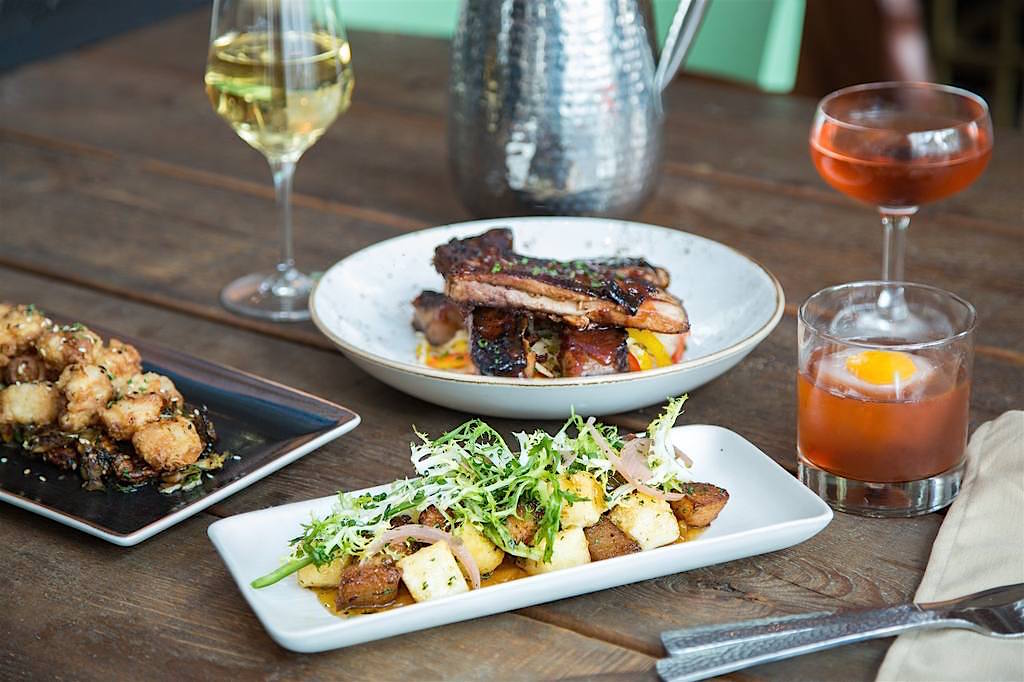 his
“96-hour” ribs are lashed with sorghum-sesame
glaze with a jicama slaw ($16). Onions
are caramelized and put to good use in plump, hot
beignets with cotija corn
and a jalapeño-laced ranch dressing ($14).
his
“96-hour” ribs are lashed with sorghum-sesame
glaze with a jicama slaw ($16). Onions
are caramelized and put to good use in plump, hot
beignets with cotija corn
and a jalapeño-laced ranch dressing ($14).
Plump
local grouper was cooked impeccably, served with
squash, tomato, corn and a richly satisfying
beurre blanc ($28), as was a Caribbean red snapper
with a shot of pico de gallo
and chorizo-flecked fried rice for bite and a
creamy black bean puree ($35). Caramelized
onions play a part in a dish of chicken with farro
risotto ($25), while the cast-iron seared ribeye
is the most savory of the main courses, served
with Cabrales butter, roasted fingerling potatoes
and bitter greens ($38).
For dessert, there’s no way to
refuse the fresh donuts with dulce de
leche, but the maple croissant bread pudding
($10) should be right beside it.
If
a case could be made—and it cannot just yet—that
Peruvian food is the next hot trend, LA MAR
in the Mandarin Oriental Hotel (500 Brickell
Key Drive; 305-913 8288) on the mainland
seems well in the vanguard in America. The
consultant here is Gastón Acurio, chef, writer, and promoter
of Peruvian culinary arts, whose “500 Años de
Fusión” was voted the best cookbook
worldwide at the 2008 Gourmand World Cookbook
Awards.
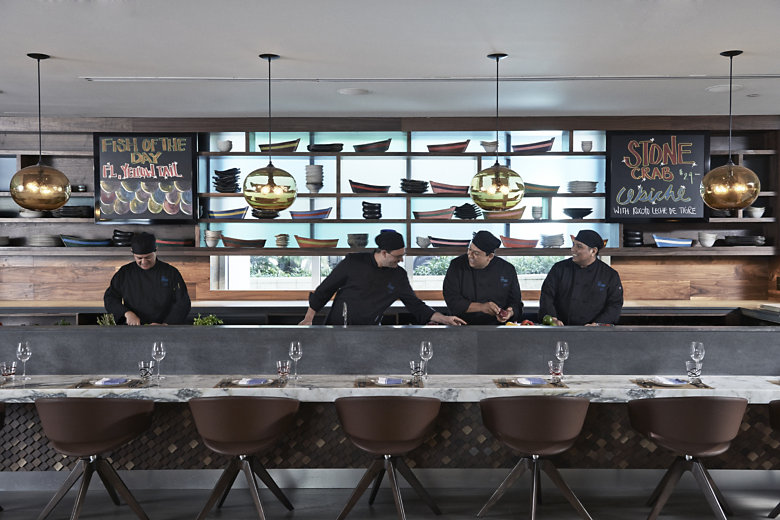 On site is
Executive Chef Diego Oka, born and raised in Lima, who
credits his grandmother’s cooking and his
Japanese-Peruvian heritage as principal
influences. Working for Acurio, Oka has helped
open La Mar restaurants in Lima, Bogotá and San
Francisco.
On site is
Executive Chef Diego Oka, born and raised in Lima, who
credits his grandmother’s cooking and his
Japanese-Peruvian heritage as principal
influences. Working for Acurio, Oka has helped
open La Mar restaurants in Lima, Bogotá and San
Francisco.
La Mar Miami is a handsome
restaurant set on the level of the bay (upstairs
is the hotel’s fine dining restaurant, Azul), with
jewel-like colors and a long Anticuchos Bar set in
front of the cooks. The dishware is folkloric, the
tables bare, the lighting set in a beautiful
fishnet configuration. I dined at lunchtime, so I
cannot comment on what seems would be a pretty
loud room of hard surfaces.
Those anticuchos
($10-$15) are a good way to go here, choosing a
slew for a meal that will include unusual dishes
like veal heart with potatoes, chocli,
tari
sauce and chaleca
(I’ll let you look all those up; they were new to
me).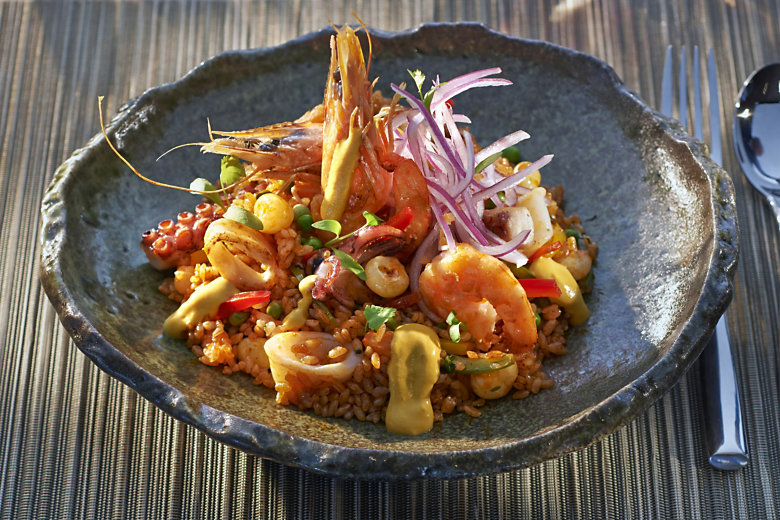
There are eight cebiches
($16-$18, with a $29 sampler) that include a “clasico”
with fluke and aji limo
pepper, red onions and leche de
tigre citrus marinade, and a delicious “barrio”
of yellowtail, mussels, shrimp, crispy calamari
and more leche
de tigre.
The influence of Japanese sushi on Peruvian
kitchens is evident here in sashimi spiced with
much the same ingredients as the cebiches,
and the nigiri
dishes include items like yellowtail with
sweet potato and pepper sauce ($9).
There’s a lot of invention in the cooking
here, plenty of counterpoint flavors and textures,
including very good snapper with dry potato stew,
peanuts, salsa
criollla and a complex ocupa
sauce of peanuts, onions, peppers and cheese
($25). Odd then that Oka serves farm-raised
salmon—not a fish big in Peruvian cuisine—with
trendy veggies like kale and bok choy ($29). I loved
the “chaufa
aeropuerto” of aji panca
fried rice with seafood ($26).
There’s
still more to learn from desserts like Peruvian
chocolate mousse with caramelized Andes grains and
lucuma fruit
bombs ($11).
With such a panoply of flavors
and exotic preparations, if Peruvian food is
really to take off in this country, La Mar is a
convincing place for it to begin in earnest.
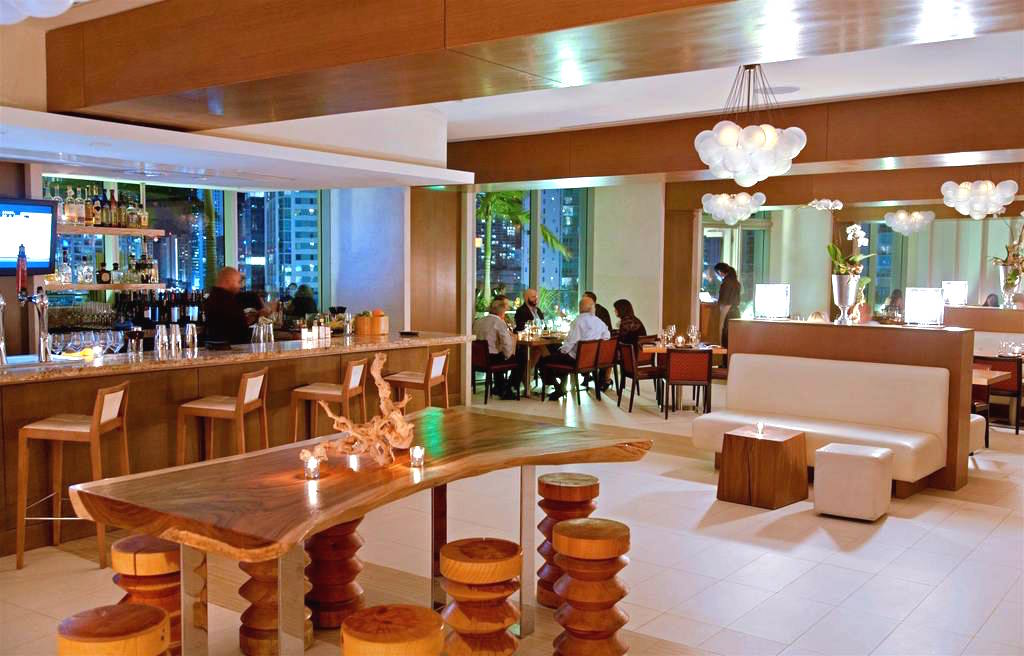 Set on the
16th floor of the Epic Hotel, AREA 31
(270 Biscayne
Boulevard Way; 305-913-8358) has a panorama of striking beauty
throughout the day and night, but most
breathtakingly at twilight, when the lights come
on in the shimmering new buildings and play
against the silver splashes of flowing water. Here
Executive Chef Wolfgang Birk, once chef at the
Versace mansion, is offering some of the most
sophisticated food in Miami right now, much of it
with Asian notes.
Set on the
16th floor of the Epic Hotel, AREA 31
(270 Biscayne
Boulevard Way; 305-913-8358) has a panorama of striking beauty
throughout the day and night, but most
breathtakingly at twilight, when the lights come
on in the shimmering new buildings and play
against the silver splashes of flowing water. Here
Executive Chef Wolfgang Birk, once chef at the
Versace mansion, is offering some of the most
sophisticated food in Miami right now, much of it
with Asian notes.
Unfortunately, the restaurant
has chosen deliberately to be a very, very un-sophisticated,
loud room, so much so that our party of six chose
a private room with its door shut to the din.
We started off with a cold corn
shooter with pine oil foam (not as bad as it
sounds), then moved on to very good mahi seviche
with hibiscus and grilled nori seaweed
($21). Although overcooked,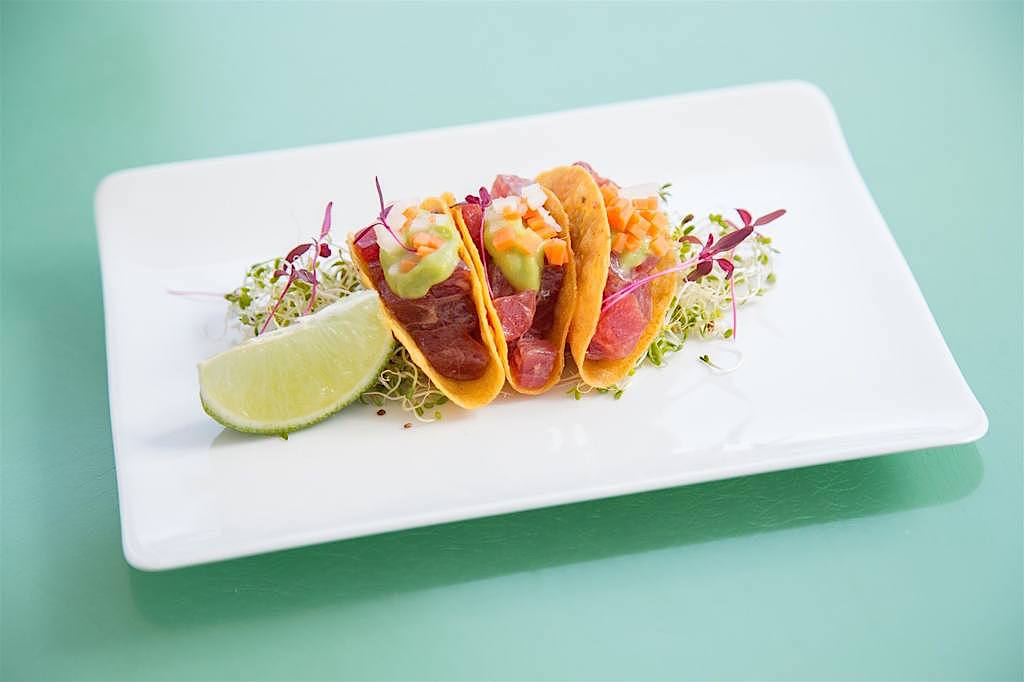 the pappardelle
with a rich oxtail sauce ($23) was a fine, hearty
dish, and the Berkshire pork with watermelon ($42)
was as refreshing as it was delicious. A whole fish—hogfish
that night—done tempura style, with wild fennel
salad and black bean sauce ($40) was expertly
fried crisp and came in a huge portion big enough
for two. The
very best of the side dishes were some fingerling
potatoes with a Parmesan cream, scallion and
garlic ($11).
the pappardelle
with a rich oxtail sauce ($23) was a fine, hearty
dish, and the Berkshire pork with watermelon ($42)
was as refreshing as it was delicious. A whole fish—hogfish
that night—done tempura style, with wild fennel
salad and black bean sauce ($40) was expertly
fried crisp and came in a huge portion big enough
for two. The
very best of the side dishes were some fingerling
potatoes with a Parmesan cream, scallion and
garlic ($11).
Desserts
toe a less imaginative line with macaroons,
chocolate mousse, panna cotta and cheesecake with
Graham cracker crust.
❖❖❖
LOCATION, LOCATION FOR TWO ITALIAN RESTAURANTS
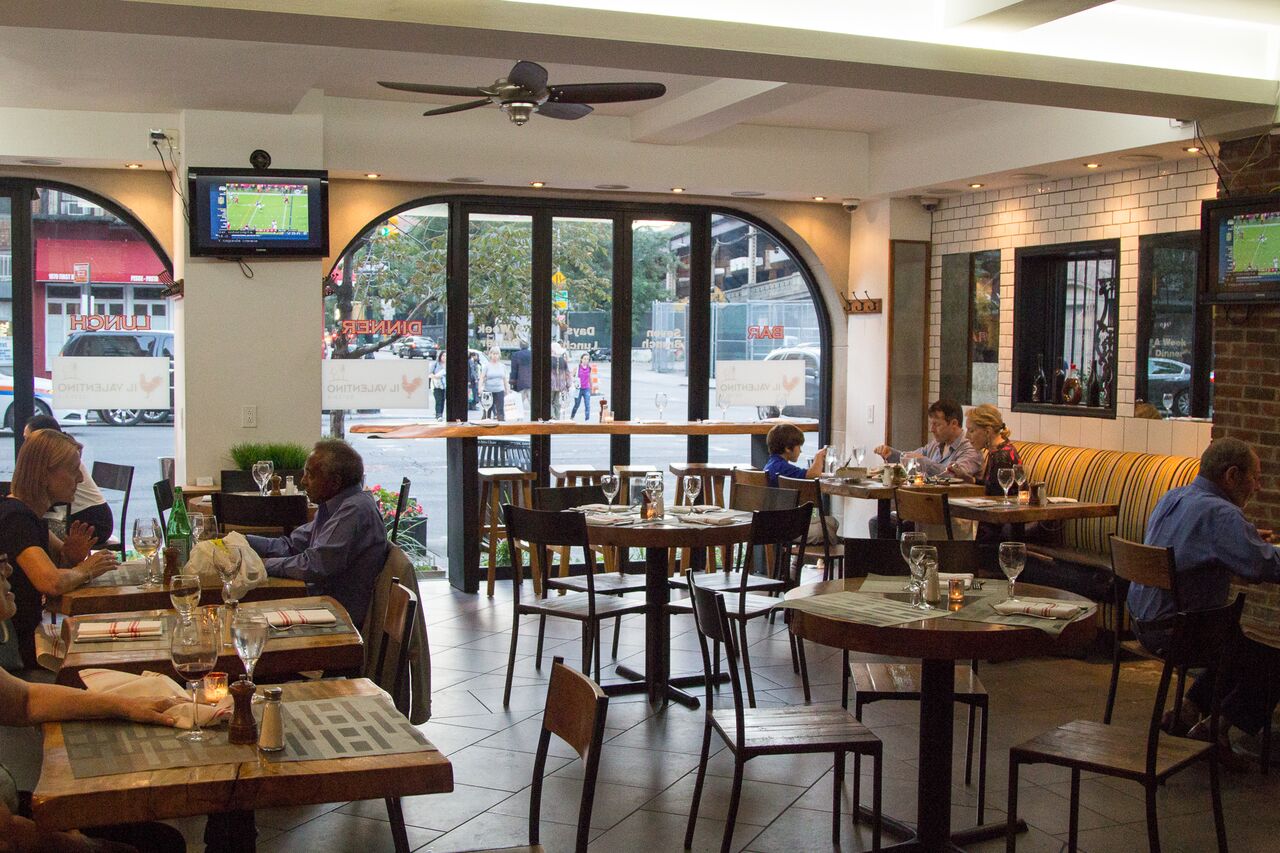 IL VALENTINO OSTERIA
IL VALENTINO OSTERIABy John Mariani
1078 1st Avenue (at 59th Street)
212-784-0800
ilvalentinonyc.com
Il
Valentino had had a long, 20-year tenure
and a very faithful clientele at its first
location on East 56th Street, a stretch much in
need of a good Italian eatery. Fortunately, the
owners have moved a few doors away to new quarters
in what had long been a faded Turkish restaurant
with kitschy décor, now replaced to look more like
a rustic trattoria of white brick walls, cafe
chairs, and leather banquettes.
It’s a cozy, casual place, has
the requisite TV screens for those ordering a
pizza and a glass of wine, along with wholly
unnecessary piped-in Italian music no one is
listening to.
Perhaps because the staff is still in
training, my party found that getting their
attention required some doing, and the owner of
the place sat all night chatting with his friends,
his back to the dining room.
There’s plenty of good food
here, starting with the pizzas that have just the
right heft of crust and melding of ingredients,
brought steaming from a new brick oven, and the
menu is long, though not, as claimed, particularly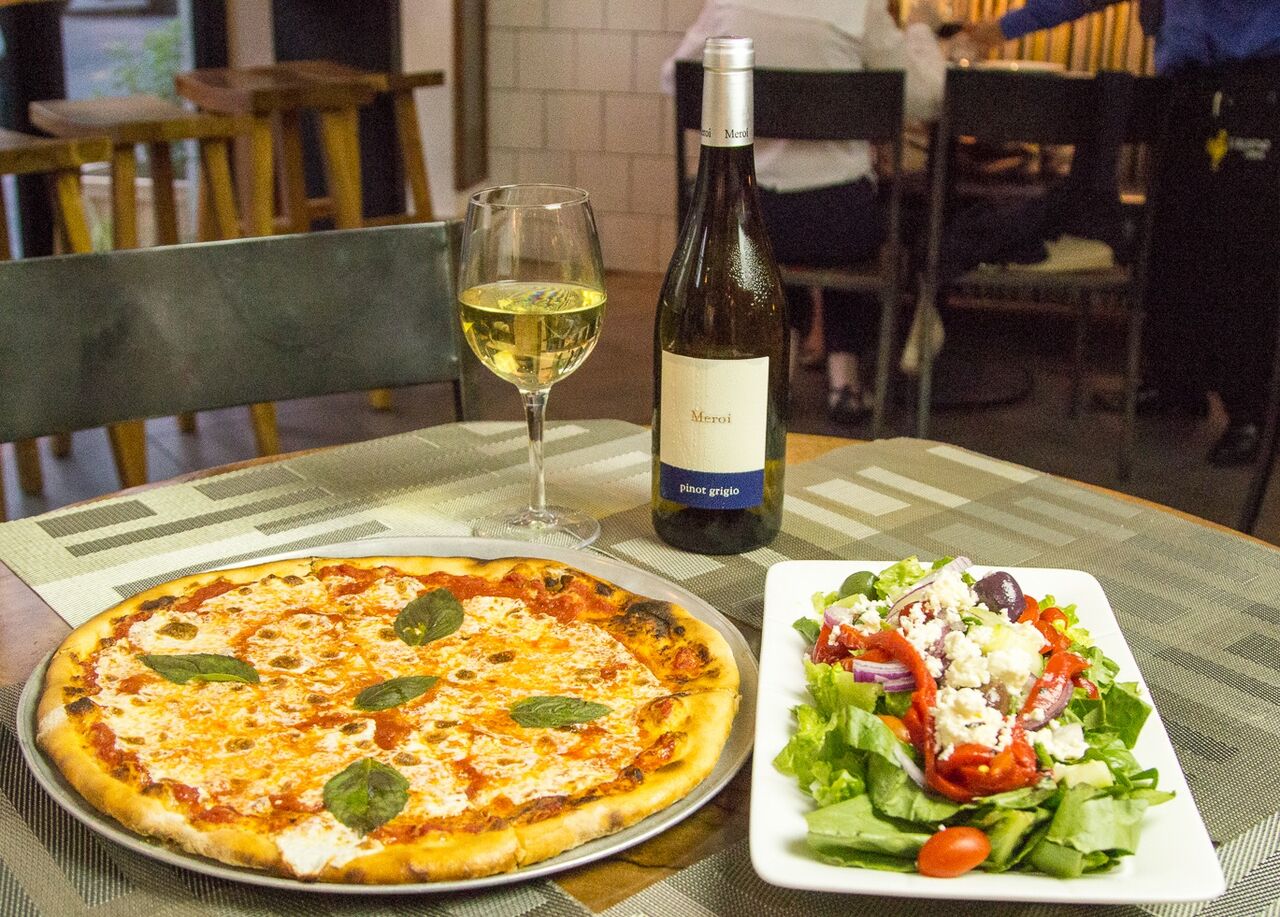 Tuscan. The “macellaio”
pizza with sweet sausage, red onions, tomatoes,
and homemade
fresh mozzarella ($17) was a hit at our table, as
was another, with black truffles, fontina,
ricotta, mozzarella and truffle oil, well worth it
at $26, serving for as a starter.
Tuscan. The “macellaio”
pizza with sweet sausage, red onions, tomatoes,
and homemade
fresh mozzarella ($17) was a hit at our table, as
was another, with black truffles, fontina,
ricotta, mozzarella and truffle oil, well worth it
at $26, serving for as a starter.
There are nicely fried, crispy calamari and
zucchini ($14) and carpaccio of
raw beef ($18), along with generous portions of
pastas like rigatoni
alla buttera with sweet and hot sausages,
peas and tomato ($13/$18); bucatini
all’amatriciana with a lusty sauce of
onion, tomato, and pancetta
($13/$18); delicious butternut squash ravioli with
a light brown cinnamon and sage sauce ($17/$22),
and a lasagna “of the day” that will easily feed
two as a pasta course.
They also use that brick oven to cook
chicken breast marinated with potato and tomato,
giving it all a smoky flavor and succulent texture
($22). Braised
lamb was equally juicy, served with figs, carrots,
quinoa and almonds ($28) and it evoked Mediterranean
flavors of the South; striped bass cooked on
the griddle came with a similarly Mediterranean
grilled eggplant and cherry tomato accompaniment
($28).
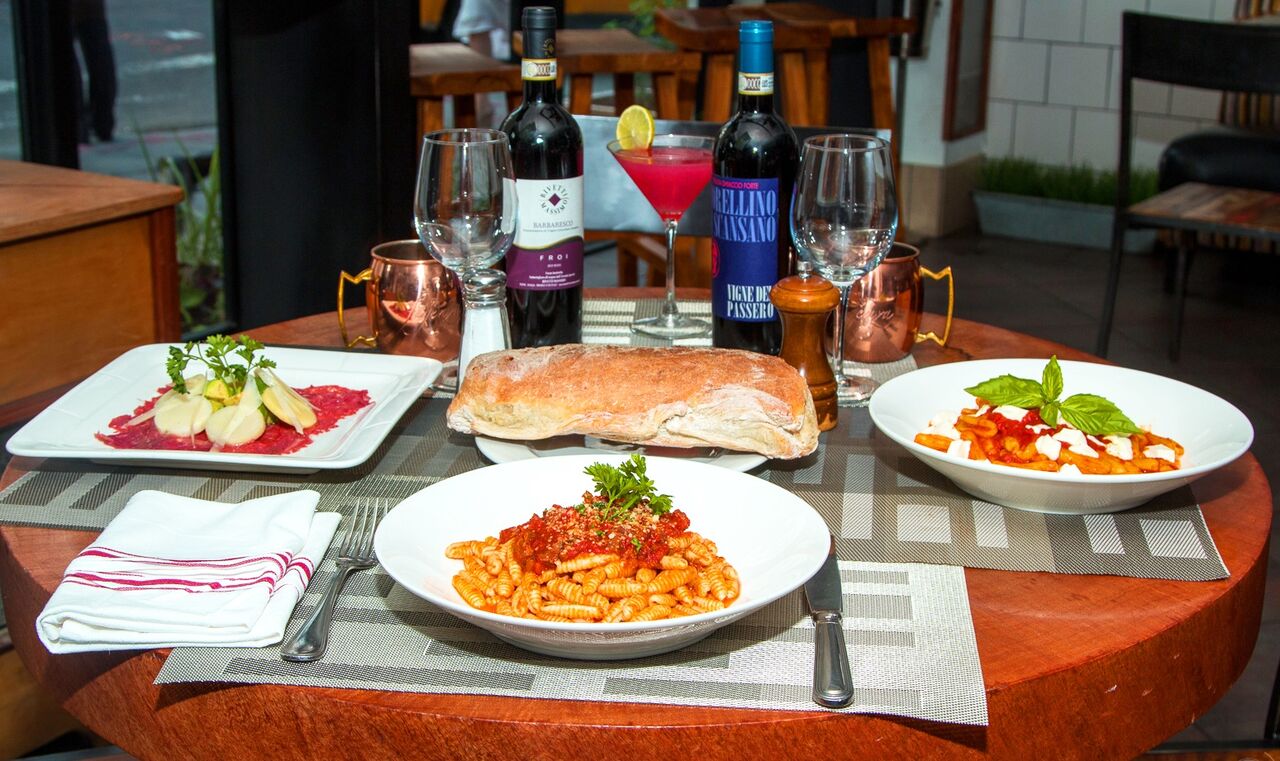 For
dessert there’s a pizza--now served all over
town-- topped with rich hazelnut-chocolate Nutella
($18). The
wine list is quite modest and needs bolstering.
For
dessert there’s a pizza--now served all over
town-- topped with rich hazelnut-chocolate Nutella
($18). The
wine list is quite modest and needs bolstering.
It’s
good to have Il Valentino back in this
neighborhood near the 59th Street Bridge,
especially for anyone headed home wanting a bite
or a pizza to go.
Otherwise, those faithful to its original
location seem to have found its new address and
its menu intact.
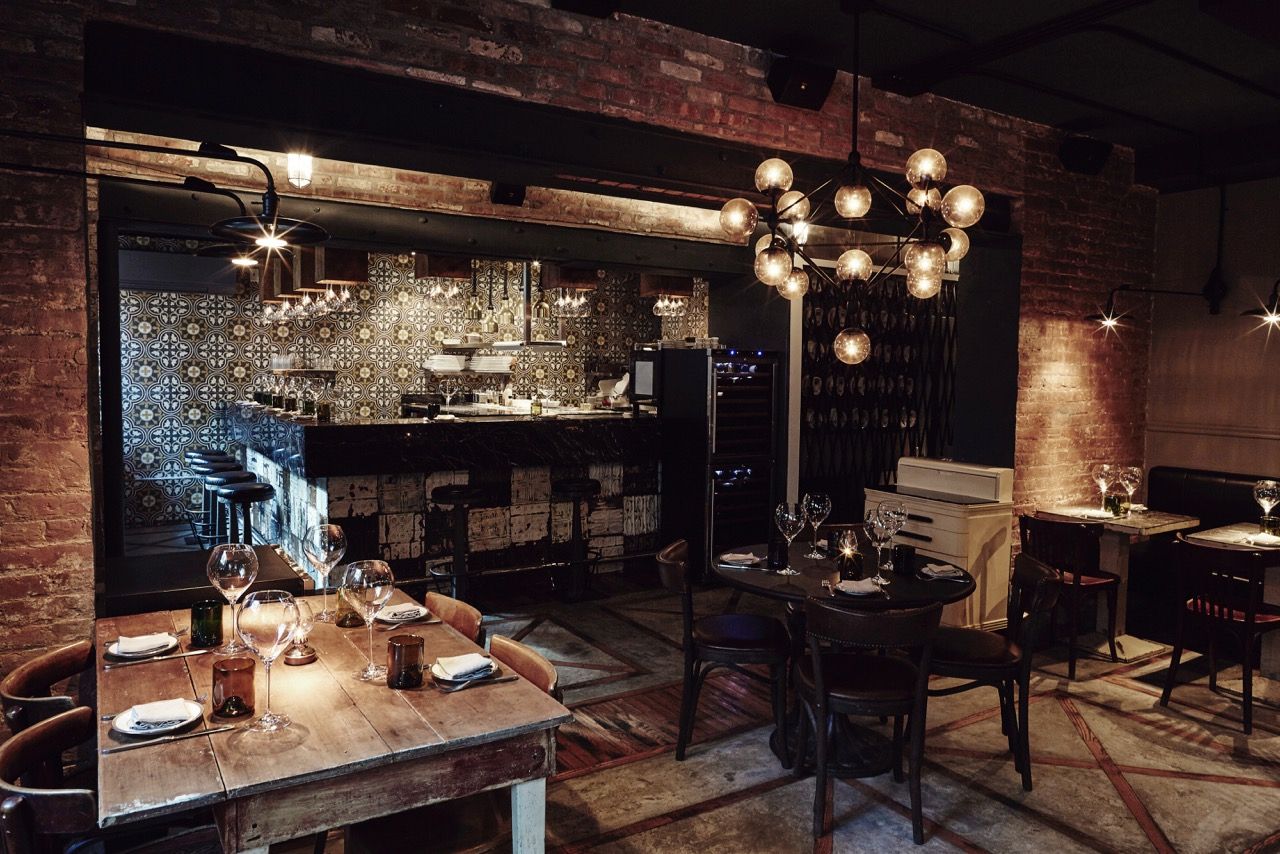 MULINO
A VINO
MULINO
A VINO
By Mort Hochstein
337 W 14th Street
(off Ninth
Avenue)
855-343-4513
www.mulinoavino.com
Not
so very long ago it was wise to avoid much of West
14th Street called the Meatpacking District, once
home to huge butchering firms, jammed with giant
trucks and men in blood-spattered aprons in the
daytime, dotted with ladies of the evening after
dark.
That’s now ancient history. The
butchers are gone, replaced by fashionable
restaurants, art galleries, hidden clubs, high
style boutiques and upscale international
retailers. The dividing line might start on
the corner of Ninth Avenue on the west toward the
more prosperous blocks, and on the east toward an
area in transition.
Mulino a Vino is on the east and is a
secluded cellar restaurant. But for Paolo
Meregali, owner and a member of the family that
produces Fertuna Estate wines, the location hasn't
been a problem. New York’s Italian ex-pats
have found the place. 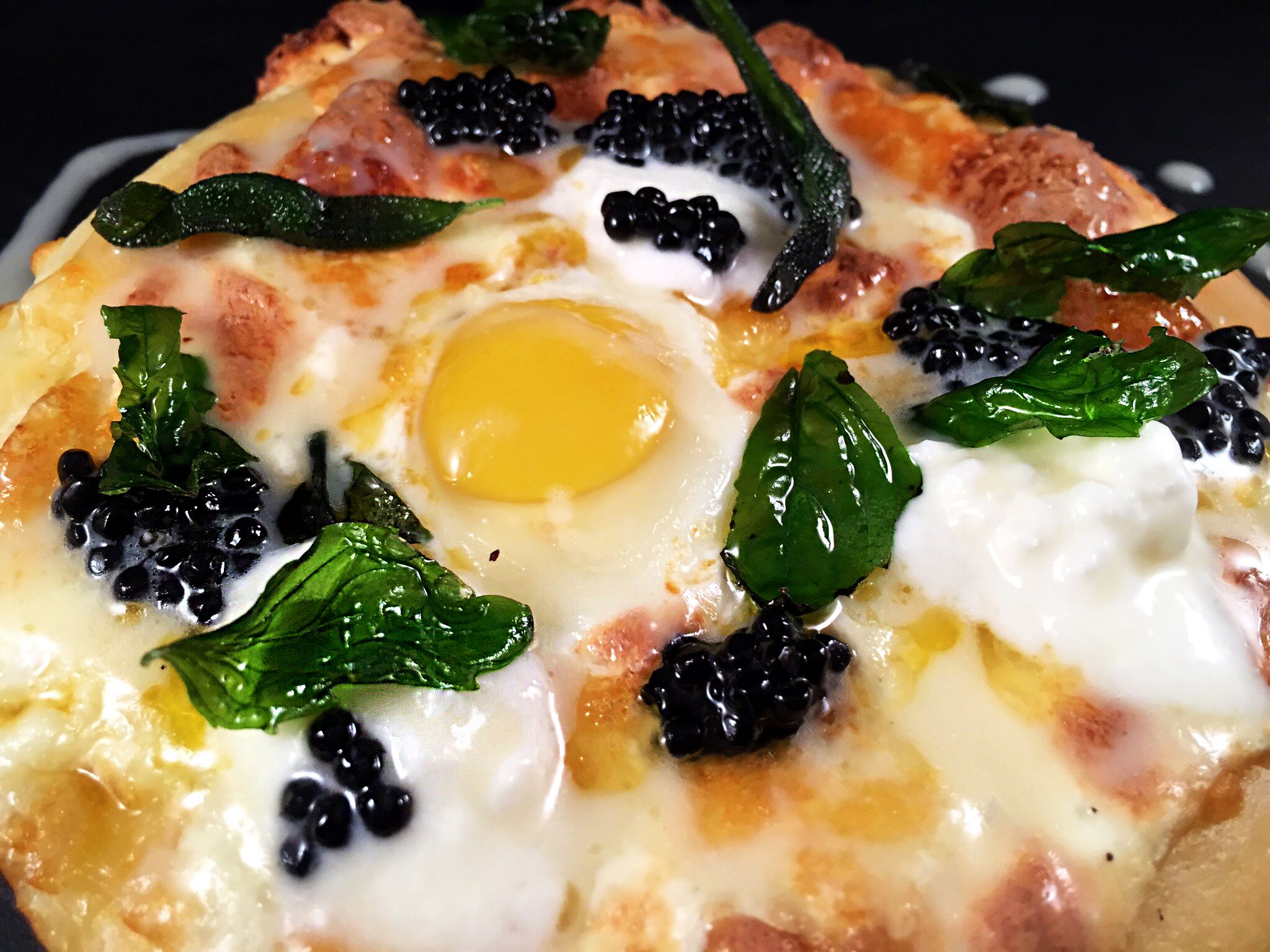
Coming downstairs, you pass an open
kitchen and small bar before entering the dining
room, framed by open brick walls, oak plank floor
of and painted concrete. A soft glow from
vintage-style industrial lighting
gives warmth to the dining room. At the
back of the house, a large table for groups sits
off the wine storage area neighboring on a more
intimate space for lounging in leather
chairs. The room has the feel of an
upscale farmhouse restaurant in Tuscany, albeit
one with an extraordinary wine list curated by
Meregali.
Chef
Davide Scabin, who made his name with the
ultra-experimental restaurant Combal.Zero near
Turin opened the NYC restaurant but has since
returned to Italy, leaving his surrogate,
Massimiliano Eandi to run Mulino a
Vino, the name a pun on mulino a vente,
the Italian name for a windmill.
Mulino is a wine-focused restaurant,
emphasized on the menu and by the tableside
pouring of wines by the glass.
Ordering can be complicated: Dishes are classified
as "Bright and Lively" and "Big & Luscious,"
and can be requested in three sizes. Esoteric? Oh
yes. Think about Bombolone
Amatriciana, an Italian “Pasta Doughnut”
filled with Amatriciana cream, or "Garden of
Eden," a mushroom and broccoli tempura, or black
truffle "Caviar," with vegetables on leaves of
baby romaine. The
wine list is
equally exotic with by-the-glass selections
ranging from $17 to $500.
Our initial visit had two purposes, first
for exposure to the restaurant and second to
sample the wines of the Fertuna Estate, founded by
wine merchant Guiseppe Meregali, father of the
restaurant’s proprietor, and enologist Ezio
Rivella, in partnership with Tenuta San Guido,
producer of Sassicaia.
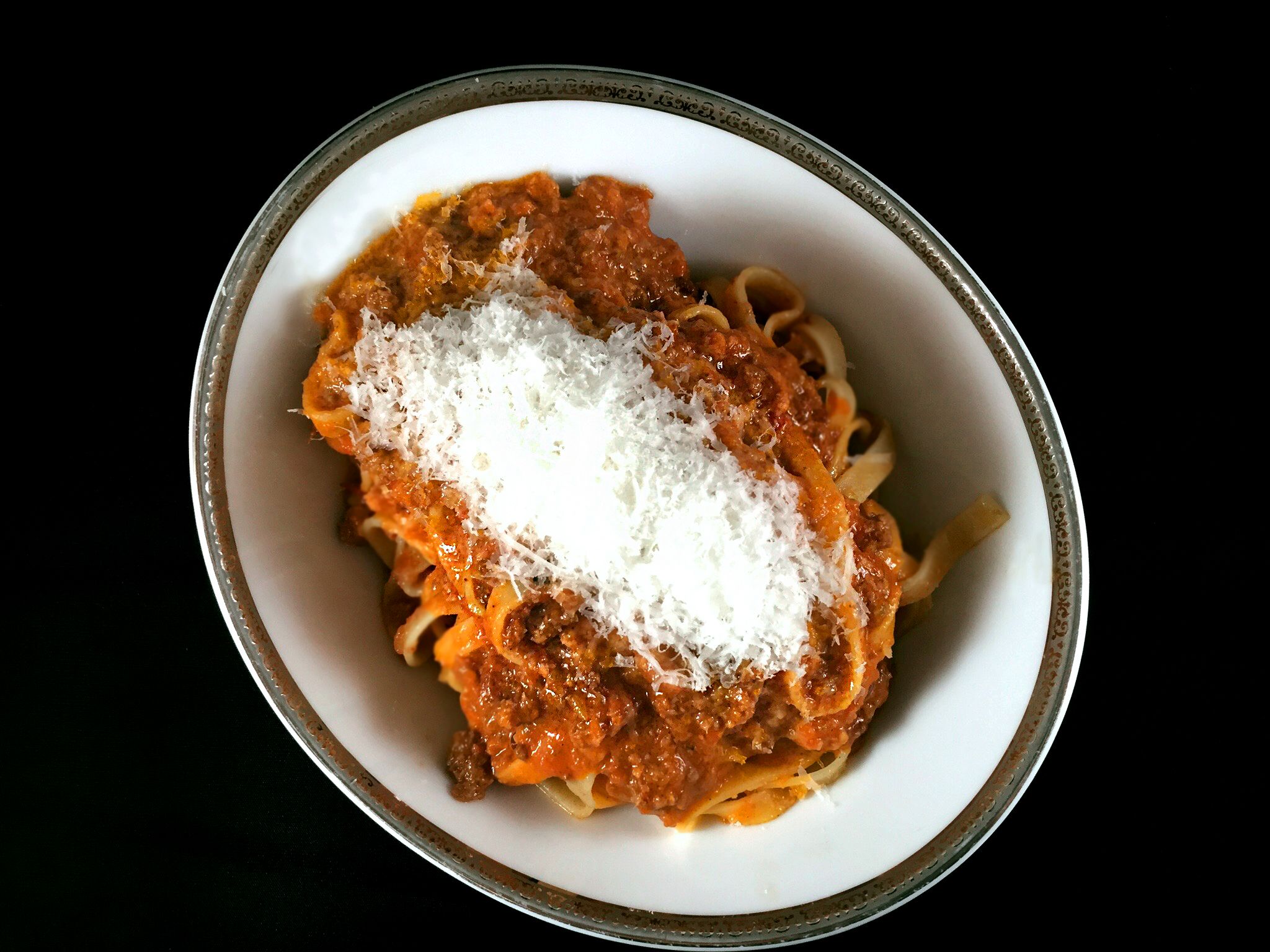 On a recent
weekday evening, the house was full, largely with
guests speaking Italian. Our group was treated to
several extraordinary presentations from Eandi.
The key appetizer was a dish he called "Cecina on
the Rock," a chickpea crêpe with a scattering of
zucchini, tomatoes, pickled red onion, mint and
olive tapenade on a rock of pink salt.
On a recent
weekday evening, the house was full, largely with
guests speaking Italian. Our group was treated to
several extraordinary presentations from Eandi.
The key appetizer was a dish he called "Cecina on
the Rock," a chickpea crêpe with a scattering of
zucchini, tomatoes, pickled red onion, mint and
olive tapenade on a rock of pink salt.
It was attractive to the eye and pleasing
on the palate, as was a striking wine from
Meregali-- Droppello, an unusual wine termed
Toscana Bianco Sangiovese, resembling a normal
white, though slightly heavier on the palate.
Eandi also
served up another esoteric starter: spaghetti that
had never been in water. cooked instead in a
large heirloom tomato, which formed a natural
edible serving dish. I wouldn’t say it was tastier
or more appetizing than normal pasta, but the
presentation was striking. This was was
mated with Fertuna Pactio-IGT, largely
Sangiovese, with 30% Cabernet Sauvignon and
10% Merlot, a wine whose acidity heightened the
flavors of the tomato and the spaghetti.
Meregali
also proudly introduced us to his top-of-the-line
super Tuscan, Lodai-IGT Maremma Toscano Rosso,
which had the same components as the Pactio, but
in different proportions, 50% Sangiovese, 40%
Cabernet Sauvignon and 10% Merlot. It was
paired with the main course, "Lamb Volcano,"
a slow-cooked roasted lamb, dressed with green
pepper and parsley foam, and dehydrated black
spaghetti powder, oyster mushrooms and a
smattering of pecorino fondue, a far cry from
traditional Italian cooking.
The dessert list is limited,
and we settled on tiramusu, with soft mascarpone
cream, white chocolate crumbles and chocolate
mousse.
Tasting through the flavor
pairings and multi-ingredient plates, I
occasionally longed for something more basic, less
embellished. Eandi, like his mentor, is given to
pushing the envelope, overdoing the flavor
combinations. The homemade pastas are a saving
grace.
The restaurant, with its subterranean site
in the basement of an apartment building, turns
out to be a buried treasure, though digging for
the gems may be arduous.
Menu items are
served family style, and come in three sizes,
depending upon the number of diners. Menu
items range in price from $10 to $50.Mulino a Vino is located
at 337 W 14th St. and is open daily for dinner
from 6 p.m. to midnight.
By Brian Freedman
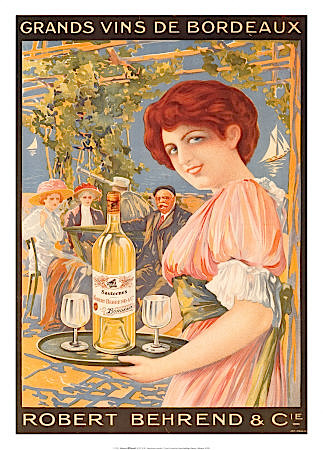
Rosé de piscine, rosé de piscine:
This past June, during a weeklong trip to
Bordeaux, I kept on hearing mention on this
mysterious “swimming-pool rosé.” For the life of
me, I couldn’t figure out what it meant. This
being Bordeaux, home of some of the most lauded,
expensive wines on the planet, my initial
assumption was that rosé de piscine
referred to a white wine that could be enjoyed by
the swimming pool in the springtime warmth, a
complex-yet-lithe vin blanc whose subtlety
was exquisitely matched by its unselfconscious
Sauvignon Blanc and Semillon layers of citrus,
herb, and lanolin.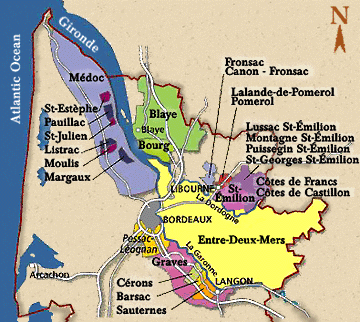
Or something like that.
I could not have been more
wrong. Because once I finally asked what this
mysterious, perhaps mythical rosé de piscine
was, I was told this: It’s a rosé that, in order
to chill it down to temperatures more appropriate
to swigging by the pool, is served in a glass with
ice cubes.
This was Bordeaux?
Indeed it was. And I had much to learn.
I had been to the region
before, and had marveled at the grands vins
of the great châteaux. I’d stood in awe at the
colonnades of those totemic structures, and gently
wended my way through the cellars of some of them,
imagining how, hundreds of years earlier, the
founding fathers of my own country had done the
same (though, ostensibly, in knickers and
ruffle-cuffed shirts, as opposed to my Pumas and
jeans). And not once during those previous visits
had anyone mentioned a concept even remotely
approaching swimming-pool wine. I had always
perceived a deep sense of joie de vivre in
Bordeaux, but of the more subtle sort, and usually
it was in the context of a more serious and
hide-bound wine culture. This, then, was
completely, utterly unexpected.
Is it possible that Bordeaux is
changing?
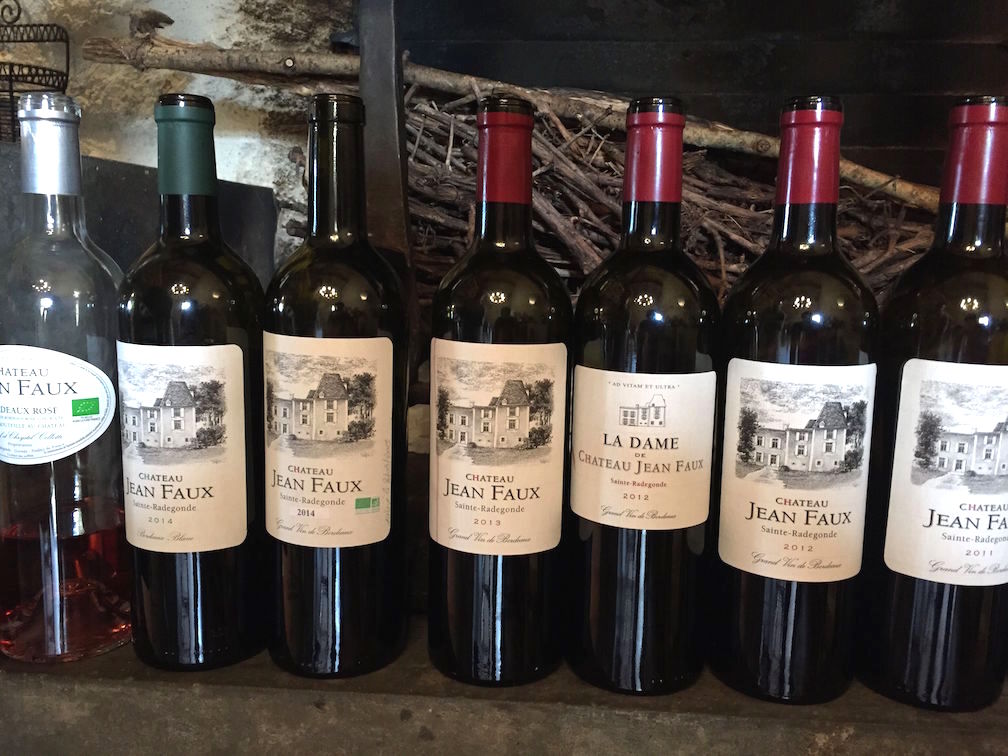 Well,
no. And also: Yes. Bordeaux occupies a very
special place in the world of wine, which is an
understatement akin to me writing that Al Pacino
is a pretty decent actor, or that the "Mona Lisa"
is not too shabby as far as portraits go, or that
Ben Carson’s views on history and geopolitics are
perhaps a little off-kilter. Indeed, Bordeaux is
more than a wine region; it’s a symbol of the
glories of French wine, and for many wine lovers,
it has achieved a level of importance far beyond
simply that famous juice in the bottle. Bordeaux
is a beverage and symbol and an aspiration all in
one. As a child, I knew we were celebrating an
important occasion whenever my parents opened up a
bottle of Bordeaux and poured me a splash. Even
today, the importance of its role in the history
of my family is impossible to overstate: My
high-school graduation was toasted with a glass of
Château La Louvière. My father’s 65th birthday was
celebrated with a Château Ducru-Beaucaillou 1982.
My nephew’s bris was consecrated with
Giraud-Larose.
Well,
no. And also: Yes. Bordeaux occupies a very
special place in the world of wine, which is an
understatement akin to me writing that Al Pacino
is a pretty decent actor, or that the "Mona Lisa"
is not too shabby as far as portraits go, or that
Ben Carson’s views on history and geopolitics are
perhaps a little off-kilter. Indeed, Bordeaux is
more than a wine region; it’s a symbol of the
glories of French wine, and for many wine lovers,
it has achieved a level of importance far beyond
simply that famous juice in the bottle. Bordeaux
is a beverage and symbol and an aspiration all in
one. As a child, I knew we were celebrating an
important occasion whenever my parents opened up a
bottle of Bordeaux and poured me a splash. Even
today, the importance of its role in the history
of my family is impossible to overstate: My
high-school graduation was toasted with a glass of
Château La Louvière. My father’s 65th birthday was
celebrated with a Château Ducru-Beaucaillou 1982.
My nephew’s bris was consecrated with
Giraud-Larose.
But this past trip to Bordeaux
introduced me to another side of the region—to its
more playful, perhaps flirty side. The trip was
sponsored by Planète Bordeaux, a consortium
representing and promoting the glories of Bordeaux
and Bordeaux Supérieur, including its seven AOCs
and the infinite range of expressions within them.
There was a whole world—indeed, a planet—to
explore.
Château L’Isle Fort was a fantastic
place to begin, a Bordeaux Supérieur producer
whose history goes back only to 2000, and whose
wines won me over from the start. Their L’Isle Douce
2014 was a crunchy, strawberry- and
watermelon-tinged rosé that I wish I’d had more of
this summer to quench my thirst in the season’s
heat. They also produce a number of quite serious
reds with real potential for aging in the
cellar—they are benefiting from the help of
consultant and wine star Stéphane Derenoncourt—and
the savory, mulberry-bursting Chapelle L’Isle 2011
and the structured, high-toned L’Isle Fort 2011,
among their other bottlings and vintages, are well
worth seeking out.
The range of styles in these
AOCs is far broader than Bordeaux often gets
credit for. Côtes de Bordeaux producer Chȃteau Lamothe de
Haux’s 2014 blanc, a beautiful
blend of 40% Sauvignon Blanc, 40% Sémillon, and
20% Muscadelle, was both crisp and aromatically
lifted, and its honeyed and orange blossom flavors
made it an excellent sipper on its own and a great
accompaniment to foie gras on crostini that
we enjoyed alongside it. For a more classic foie
gras pairing, Chȃteau
du Cros, in Loupiac, owns the oldest
Sémillon vines in Bordeaux—their “Centenary Plot”
is 108 years old—and their 2004 “La Tradition”
bottling, crafted from the fruit of those
century-old vines and only produced in the best
years (they’ve done four in the past 12 years), is
intensely delicious, with smoky aromas anchoring
flavors of charred lemon skin, honey, and tropical
fruit.
In
addition to my now-beloved rosé de piscine,
there are a range of pink wines being produced
here. Château
Jean Faux’s 2014 rosé, for example, is a
product of saignée, and is a big, amply structured
wine with flavors of melon and fennel. (They also
make a number of standout reds, including the
stellar Château Jean Faux 2013, which speaks of
oolong tea, eucalyptus, red-berry fruit, and
licorice, and will continue evolving until 2024
and beyond.)
Château Turcaud’s Entré-Deux-Mers
2014, with 2% Muscadelle and no residual sugar, is
a bracing, almost briny white offering, whereas
their Bordeaux Blanc 2014 “Cuvée Majeure” is more
exotic, with pineapple, vanilla pod, acacia,
jasmine and orange blossom. Château Laville
produces a tremendous assortment of wines, from
the 2010 “Eximus” bottling, with its bright acid,
clove, and dark cherry notes to the Clairet, whose
gentle extraction is the result of 72 hours of
low-temperature maceration. The result is a wine
that made me actively hungry with its dill,
saline, cranberry and fresh orange
characteristics. Château
des Arras, with its 21 hectares under
vine, produces wines that we soon discovered have
serious aging potential. Their 2000 “Cuvée
Préstige” was supple and savory, with plum,
cassis, and forest floor notes (and easily another
five-plus years of life to it); and the 2005 was
still remarkably young in character, with serious
tannic structure framing plum skin, cherry, spice
and peppercorn.
Chȃteau Maison Noble, 10km north
of Pomerol, near Blaye, produces four wines: A
traditional red, a “préstige” red, a Clairet, and
a white. Their Bordeaux Blanc “Cuvée Maurice” 2014
was crisp and creamy at one, which resulted in
terrific tension. Flavors of lemon and lime, as
well as yeast and a bit of spice, would be
phenomenal at the table. The clairet there is as
light as is permitted on the color spectrum for
the style, and the wine itself is fresh with
cherry and spice, yet anchored by excellent
concentration. And the Bordeaux Supérieur “Cuvée
Prestige” 2012, with its dark cherry, excellent
structure, and finish that hints at lavender and
meat, is a knockout.
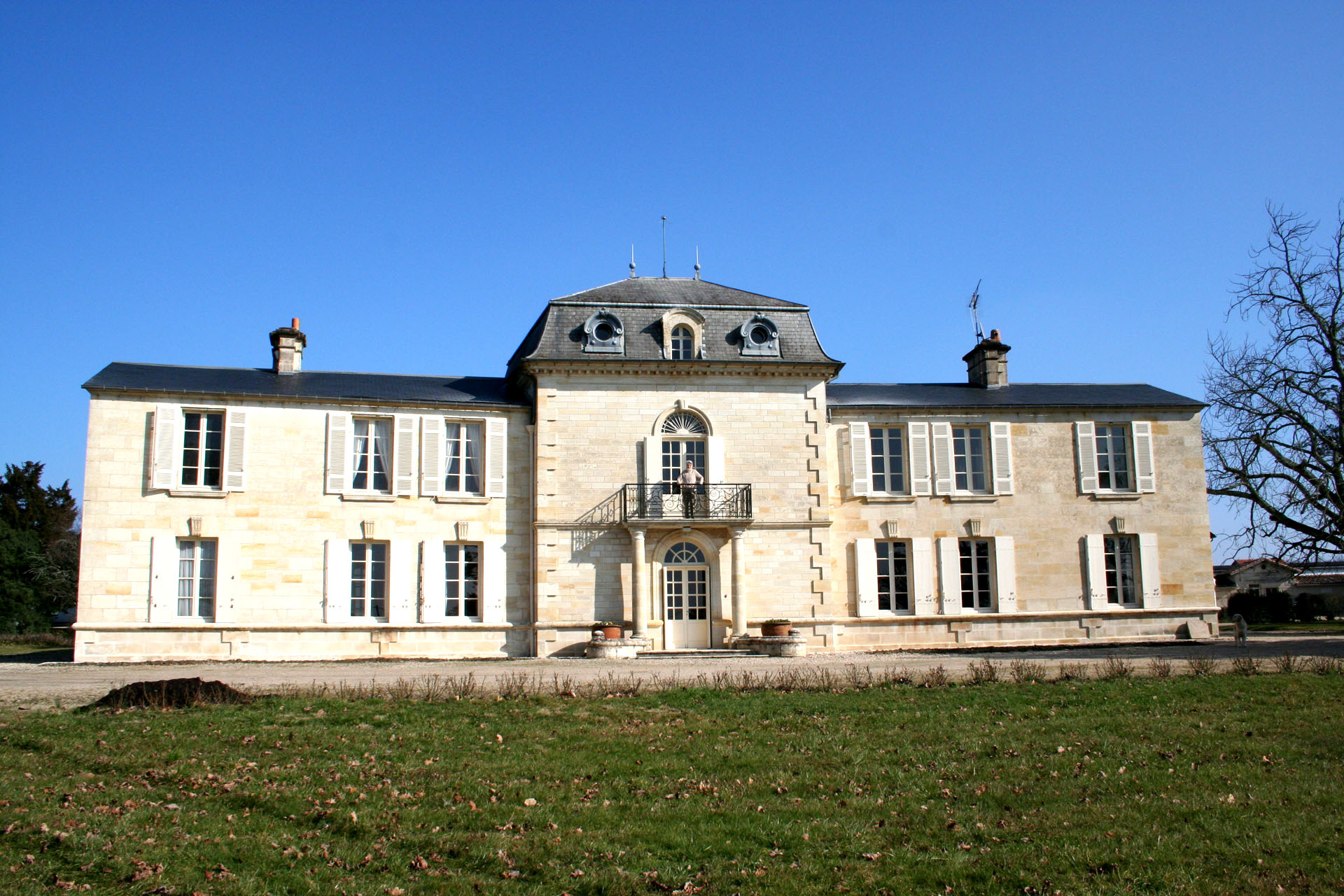 Finally, there was Château Recougne,
(left)
which, in addition to being notable for its
selection of remarkable reds, is also a
significant grower of Carmenère—with 2 hectares
under vine, they are the largest producer of the
variety in the region. Like so many of the other
producers we visited, they craft an excellent
Bordeaux Blanc and a remarkable rosé, but it was
the Carmenère-expressive Bordeaux Supérieur 2011,
with its round fruit, black licorice, cherry
liqueur and floral peppercorn notes that won me
over, as well as its Vieilles Vignes 2010 Bordeaux
Supérieur, a notably spicy wine with bakers
chocolate, mineral, and roasted coffee notes.
Finally, there was Château Recougne,
(left)
which, in addition to being notable for its
selection of remarkable reds, is also a
significant grower of Carmenère—with 2 hectares
under vine, they are the largest producer of the
variety in the region. Like so many of the other
producers we visited, they craft an excellent
Bordeaux Blanc and a remarkable rosé, but it was
the Carmenère-expressive Bordeaux Supérieur 2011,
with its round fruit, black licorice, cherry
liqueur and floral peppercorn notes that won me
over, as well as its Vieilles Vignes 2010 Bordeaux
Supérieur, a notably spicy wine with bakers
chocolate, mineral, and roasted coffee notes.
Our visit there concluded with
a wine that I still think about: The Château
Recougne 1952, a bottle that proved to me that
classic, age-worthy Bordeaux doesn’t only come
from the fabled châteaux of the 1855
classification and its equivalents. This silky,
majestic Bordeaux Supérieur, singing an aria of
mint, sandalwood, old leather, and eucalyptus on
the nose and bursting with otherworldly flavors of
graphite, blackberry and blueberry compote,
cassis, dried figs, incense, violets, plum cake,
clove and allspice, was one of the great
privileges of my wine life to taste. It was still,
53 years after the fruit was harvested, stunningly
powerful and perfectly balanced. And it stood as a
regal, utterly delicious testament to Bordeaux—not
just the part that so many consumers think of when
mention of the region as a whole comes up, but its
other, equally worthy parts, too. The wines I
tasted over the course of that week this past
spring were as eye-opening as any I’ve had in
quite some time. And seriously delicious, to boot.
❖❖❖
 BLOCK THAT METAPHOR!!
BLOCK THAT METAPHOR!!
“Fried soft-shell crab with
burrata sounded weird on the menu and was weirder on
the plate. It was like watching a bad date. I kept
waiting for one of the ingredients to get an urgent
text from a roommate who’s locked out of the
apartment.”—Pete Wells, “Chevalier,” NY Times
(8/12/15)
WHAT BOOBS THESE
MORTAL BE!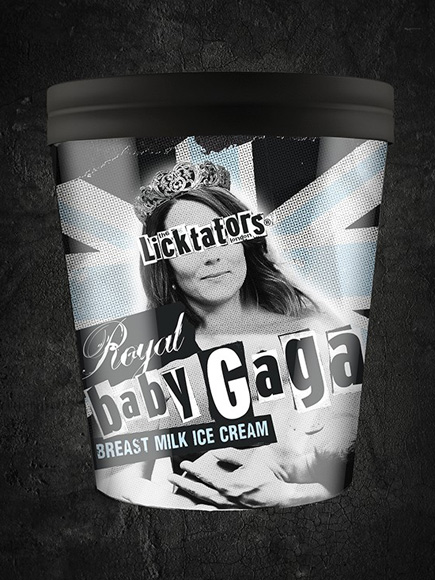
London-based
breast milk ice cream makers The Licktators are being
allegedly sued by the lawyers for Lady Gaga, for
using the company's flavor "Royal Baby Gaga,"
contending that it is confusing to consumers who might
think Gaga endorses the product. Nadine
O'Connor, a representative for The Licktators contends
that "neither names nor features Lady Gaga, nor are
her trademarks infringed. However, we will send
complimentary tubs of our ice cream to Lady Gaga for
chilling out to, as a gesture of peace and goodwill."
Any of John Mariani's books below may be ordered from amazon.com.
 I'm proud and happy to announce that my
new book, The Hound
in Heaven (21st Century Lion Books), has just
been published through Amazon and Kindle.
I'm proud and happy to announce that my
new book, The Hound
in Heaven (21st Century Lion Books), has just
been published through Amazon and Kindle. It is a novella, and for anyone who loves dogs, Christmas, romance, inspiration, even the supernatural, I hope you'll find this to be a treasured favorite. The story concerns how, after a New England teacher, his wife and their two daughters adopt a stray puppy found in their barn in northern Maine, their lives seem full of promise. But when tragedy strikes, their wonderful dog Lazarus and the spirit of Christmas are the only things that may bring back his master back from the edge of despair.
WATCH THE VIDEO!
“What a huge surprise turn this story took! I was completely stunned! I truly enjoyed this book and its message.” – Actress Ali MacGraw
“He had me at Page One. The amount of heart, human insight, soul searching, and deft literary strength that John Mariani pours into this airtight novella is vertigo-inducing. Perhaps ‘wow’ would be the best comment.” – James Dalessandro, author of Bohemian Heart and 1906.
“John Mariani’s Hound in Heaven starts with a well-painted portrayal of an American family, along with the requisite dog. A surprise event flips the action of the novel and captures us for a voyage leading to a hopeful and heart-warming message. A page turning, one sitting read, it’s the perfect antidote for the winter and promotion of holiday celebration.” – Ann Pearlman, author of The Christmas Cookie Club and A Gift for my Sister.
“John Mariani’s concise, achingly beautiful novella pulls a literary rabbit out of a hat – a mash-up of the cosmic and the intimate, the tragic and the heart-warming – a Christmas tale for all ages, and all faiths. Read it to your children, read it to yourself… but read it. Early and often. Highly recommended.” – Jay Bonansinga, New York Times bestselling author of Pinkerton’s War, The Sinking of The Eastland, and The Walking Dead: The Road To Woodbury.
“Amazing things happen when you open your heart to an animal. The Hound in Heaven delivers a powerful story of healing that is forged in the spiritual relationship between a man and his best friend. The book brings a message of hope that can enrich our images of family, love, and loss.” – Dr. Barbara Royal, author of The Royal Treatment.
 |
The Encyclopedia of American Food and Drink by John F. Mariani (Bloomsbury USA, $35) Modesty forbids me to praise my own new book, but let me proudly say that it is an extensive revision of the 4th edition that appeared more than a decade ago, before locavores, molecular cuisine, modernist cuisine, the Food Network and so much more, now included. Word origins have been completely updated, as have per capita consumption and production stats. Most important, for the first time since publication in the 1980s, the book includes more than 100 biographies of Americans who have changed the way we cook, eat and drink -- from Fannie Farmer and Julia Child to Robert Mondavi and Thomas Keller. "This book is amazing! It has entries for everything from `abalone' to `zwieback,' plus more than 500 recipes for classic American dishes and drinks."--Devra First, The Boston Globe. "Much needed in any kitchen library."--Bon Appetit. |
"Eating Italian will never be the same after reading John Mariani's entertaining and savory gastronomical history of the cuisine of Italy and how it won over appetites worldwide. . . . This book is such a tasteful narrative that it will literally make you hungry for Italian food and arouse your appetite for gastronomical history."--Don Oldenburg, USA Today. "Italian
restaurants--some good, some glitzy--far
outnumber their French rivals. Many of
these establishments are zestfully described
in How Italian Food Conquered the World, an
entertaining and fact-filled chronicle by
food-and-wine correspondent John F.
Mariani."--Aram Bakshian Jr., Wall Street
Journal.
"Equal parts
history, sociology, gastronomy, and just
plain fun, How Italian Food Conquered the
World tells the captivating and delicious
story of the (let's face it) everybody's
favorite cuisine with clarity, verve and
more than one surprise."--Colman Andrews,
editorial director of The Daily
Meal.com. "A fantastic and fascinating
read, covering everything from the influence
of Venice's spice trade to the impact of
Italian immigrants in America and the
evolution of alta cucina. This book will
serve as a terrific resource to anyone
interested in the real story of Italian
food."--Mary Ann Esposito, host of PBS-TV's
Ciao
Italia. "John Mariani has written the
definitive history of how Italians won their
way into our hearts, minds, and
stomachs. It's a story of pleasure over
pomp and taste over technique."--Danny Meyer,
owner of NYC restaurants Union Square
Cafe, The Modern, and Maialino.
|
 |
 |
 |
 |
 |
 |
 |
 |
 Everett Potter's Travel Report:
Everett Potter's Travel Report: 
 Eating Las
Vegas is the new on-line site for
Virtual Gourmet contributor John A. Curtas.,
who since 1995 has been commenting on the
Las Vegas food scene and reviewing
restaurants for Nevada Public Radio.
He is also the restaurant critic for KLAS
TV, Channel 8 in Las Vegas, and his past
reviews can be accessed at KNPR.org.
Click on the logo below to go directly to
his site.
Eating Las
Vegas is the new on-line site for
Virtual Gourmet contributor John A. Curtas.,
who since 1995 has been commenting on the
Las Vegas food scene and reviewing
restaurants for Nevada Public Radio.
He is also the restaurant critic for KLAS
TV, Channel 8 in Las Vegas, and his past
reviews can be accessed at KNPR.org.
Click on the logo below to go directly to
his site.

Tennis Resorts Online: A Critical Guide to the World's Best Tennis Resorts and Tennis Camps, published by ROGER COX, who has spent more than two decades writing about tennis travel, including a 17-year stretch for Tennis magazine. He has also written for Arthur Frommer's Budget Travel, New York Magazine, Travel & Leisure, Esquire, Money, USTA Magazine, Men's Journal, and The Robb Report. He has authored two books-The World's Best Tennis Vacations (Stephen Greene Press/Viking Penguin, 1990) and The Best Places to Stay in the Rockies (Houghton Mifflin, 1992 & 1994), and the Melbourne (Australia) chapter to the Wall Street Journal Business Guide to Cities of the Pacific Rim (Fodor's Travel Guides, 1991).


MARIANI'S VIRTUAL GOURMET
NEWSLETTER is published weekly. Editor/Publisher: John
Mariani.
Editor: Walter Bagley. Contributing Writers: Christopher Mariani,
Robert Mariani, Misha
Mariani,
John A. Curtas, Edward Brivio, Mort Hochstein,
Andrew Chalk, Dotty Griffith and Brian Freedman. Contributing
Photographers: Galina Dargery, Bobby
Pirillo. Technical Advisor: Gerry McLoughlin.
To un-subscribe from this newsletter,click here.
© copyright John Mariani 2015

